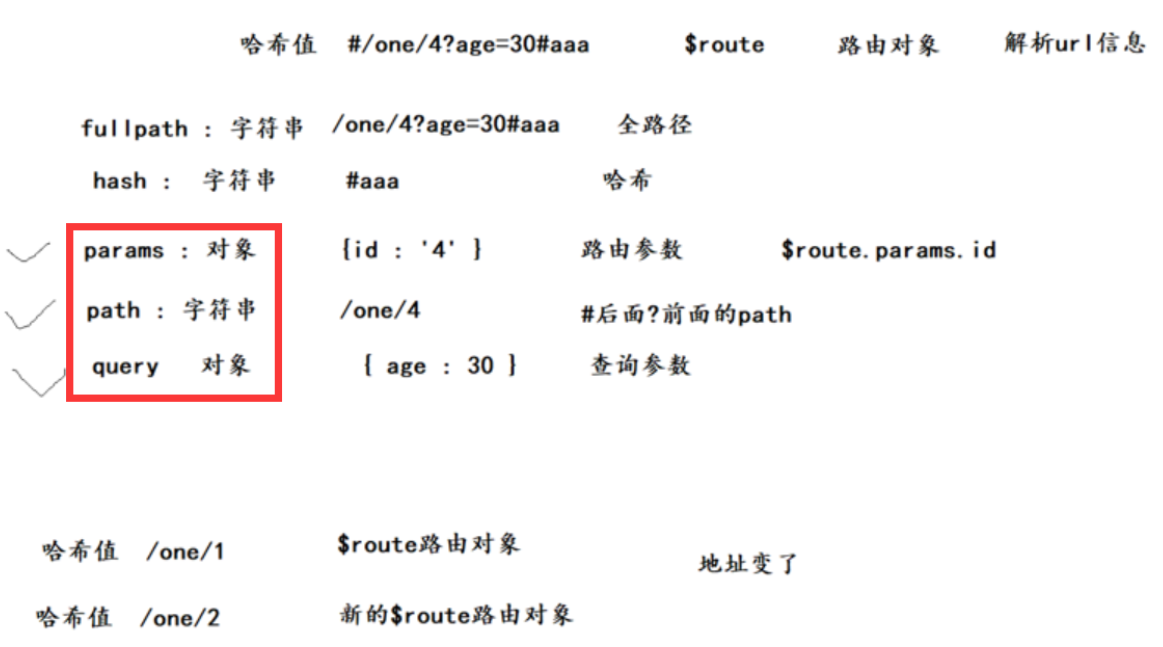

一个路由对象 (route object) :表示当前激活的路由的状态信息,包含了当前 URL 解析得到的信息
一个哈希值路径 ==> 一个路由对象
$route.path
- 类型:
string - 字符串,对应当前路由的路径,总是解析为绝对路径,如
"/foo/bar"。 # 后面、?前面的内容
- 类型:
$route.params
- 类型:
Object - 一个 key/value 对象,包含了动态片段和全匹配片段,如果没有路由参数,就是一个空对象。
- 类型:
$route.query
- 类型:
Object - 参数对象
- 一个 key/value 对象,表示 URL 查询参数。例如,对于路径
/foo?user=1,则有$route.query.user == 1,如果没有查询参数,则是个空对象。
- 类型:
$route.hash
类型:
string当前路由的 hash 值 (带
#) ,如果没有 hash 值,则为空字符串。
$route.fullPath
- 类型:
string - 全路径
- 完成解析后的 URL,包含查询参数和 hash 的完整路径。
- 类型:
# 演示 :
<router-link to="/detail/4?age=21#one">detail</router-link>
{ path: '/detail/:id?', component: detail }
在组件内 created打印 this.$route
> fullPath: "/detail/4?id=001#one"
> hash : "#one"
> params : {id:'4'}
> query : {age : 21}
> path : '/detail/4'06-$route.html
<!DOCTYPE html>
<html lang="en">
<head>
<meta charset="UTF-8" />
<title>Document</title>
</head>
<body>
<!--
$route 路由对象 解析的url信息 哈希值的url信息
- 哈希值 (#/one/4?age=30#aaa) ==> $route
-->
<div id="app">
<!-- 1. 入口 -->
<!-- <router-link to="/one/4?age=30#aaa">one</router-link> -->
<router-link to="/one/1">第一个</router-link>
<router-link to="/one/2">第二个</router-link>
<!-- 4. 出口 -->
<router-view></router-view>
</div>
<script src="./vue.js"></script>
<script src="./node_modules/vue-router/dist/vue-router.js"></script>
<script>
// 3. 组件
const One = {
template: `<div>one组件 {{ $route.params.id }}</div>`,
created() {
// 页面过程中的第一次的值,不会变化,因为created只执行一次
console.warn(this.$route.params.id)
},
// 很重要的思想(★)
// 使用watch 监听 $route 路由对象 获取里面的信息 【url变了,$route跟着变。】
watch: {
$route(newVal) {
console.warn(newVal)
console.warn(newVal.params.id)
}
}
}
// 实例化
const router = new VueRouter({
// 2. 规则
routes: [{
path: '/one/:id',
component: One
}]
})
const vm = new Vue({
router,
el: '#app',
data: {}
})
</script>
</body>
</html>